Two things begin in July: numbers of leaf-mining moth species start to produce their mines and more depressingly, the first returning migrating birds can also be expected, as early as the first week in the case of Green Sandpiper.
July at Gowy Meadows
July 8th
Patchy cloud cover with sunny spells; windier as the day wore on.
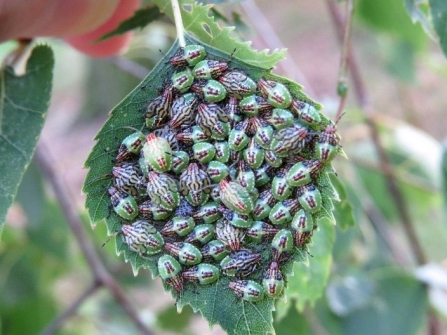
Shieldbugs c. Steve Holmes
Disregarding birds – there were almost none to make note of anyway, this was a very special day in the field in pleasant conditions. Beginning in Thornton-le-Moors woods was a good move as within moments of searching the leaves of the first Silver Birch tree, I began finding clutch after clutch of immature PARENT BUGS! To put this into context, despite this particular tree being probably the only regular site for the species on the patch, these represented just the 6th ever record! In total there were 18 batches of immatures in various stages of development, as well as three presumed females doing their thing by standing guard over their eggs. Taking a photograph of each group found enabled an accurate count of 381 immatures and three adults! Only Gorse Shieldbug comes close thanks to the colony in 4473. One group was doing its best to hide the leafmine of STIGMELLA SAKHALINELLA, the second record ever and the first since mines on the same tree on 2010. A NUTHATCH calling from the wood was an entirely unexpected first for the year.
Heading south out of the village there was little along the hedgerow until just before the entrance to Speckled Wood Lane, when by some freakish amount of luck accounted for the finding of an adult STIGMELLA SCHREBERELLA! The first adult for the patch and just the 3rd record ever following the discovery of leaf-mines on the very same tree as the shieldbug throng.
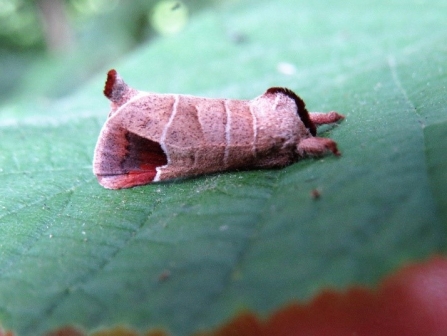
Chocolate tip moth c. Steve Holmes
Speckled Wood Lane was almost declarable as a bird-free zone; singles of Chiffchaff and Blackcap were about the best along the entire route, though there was a brief encounter with a newly fledged Robin. Even hoverflies were all but absent, with just the odd individual of several common species on show and Speckled Woods (6) were the only butterfly actually along the lane itself. Moths did however rescue the situation with new for the reserve records of both CHOCOLATE-TIP and YPSOLOPHA USTELLA. The first being found when attempting to photograph an ARGYRESTHIA BONNETELLA, itself just the 9th record ever!
Leaf-mining added Stigmella aurella, Stigmella hybnerella, Stigmella hemargyrella, and Phyllonorycter coryli so things were busy enough.
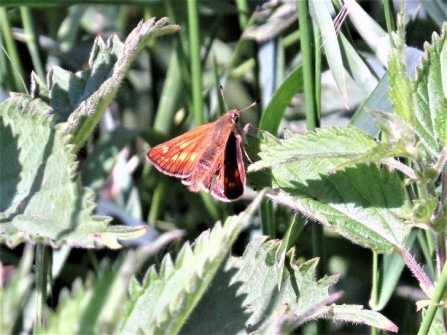
Large skipper c. Steve Holmes
Half way along the lane I made excursions into fields on either side and that to the south was very busy on the butterfly front, with the first of ‘many’ Comma butterflies seen during the day. ‘Many’ was in fact 10, but the norm is none and whenever seen, one or two a day is all that can be expected. The first Small Skippers and Gatekeepers of the year showed nicely, as did Large Skipper and scores of Meadow Browns and Green-veined Whites.
Towards the western end of the lane a Southern Hawker burst from under my nose before perching briefly in the upper levels of an Oak tree – another first for the year.
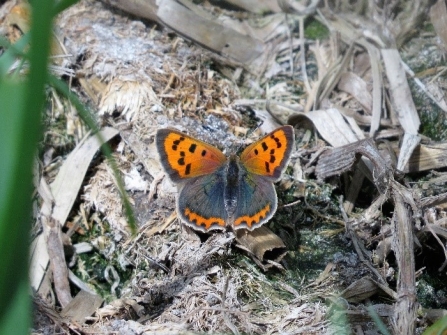
Small copper c. Steve Holmes
With the weather being as it was, a census of Banded Demoiselles seemed in order. It took an hour to get to the river as there were distractions aplenty along the route, not least of which a year high 35 Swallows over what was left of the pond in SJ4373. Sixty-five Harlequin Ladybirds were a less welcome sight but looking at a particularly nicely marked individual drew my attention to a Gypsonoma dealbana moth, which in turn led me to another reserve first, ACLERIS COMARIANA! Small Copper added itself to the growing butterfly day list.
Once at the river it was immediately obvious that there were masses of demoiselles on the wing, so a slow walk north to the A5117 was certainly called for. At times, numbers were difficult to count as patrolling Emperors caused pandemonium in their ranks. These instances aside only a handful of Azure Damselflies, one or two Brown Hawkers and the very welcome sight of a family party of Mute Swans (five cygnets) interrupted the counting. The first sighting since the nest in SJ4374 was vacated, it was good to see that it had been a successful attempt in the most bizarre place to nest!
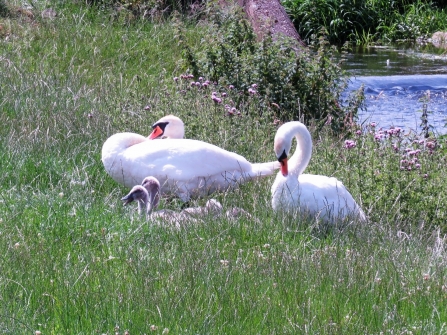
Mute swans c. Steve Holmes
By giving them a wide birth to avoid disturbing their peace and quiet I probably missed a few demoiselles but on reaching the A5117 the total was nonetheless a very respectable 1,075. It was also interesting thereafter to note that ten or more were to the east of the river along the ditch adjacent to the permissive footpath to a point well beyond where the Mute Swans had nested.
The path was a tad quiet, but the sun was now beating down quite well so it was perhaps not unexpected; at least it was still walkable following the work undertaken by Trust volunteers last year. Three Narrow-bordered Five-spot Burnets were highlights, along with several each of both skippers and scores more Green-veined Whites and Meadow Browns. The first Painted Lady of the year shot through and singles of Scaeva pyrastri and Sphaerophoria scripta put hoverflies back to the fore, if only briefly. And the last word appropriately went to moths, with several tiger-striped Cinnabar larvae were found on the numerous Ragwort and the first Shaded Broad-bar appeared at the main Common Blue site – that lacked Common Blues for once.
July 16th
Initial rain moved away around 11:30 to turn into patchy cloud cover with sunny spells.
A disappointing turn out for this Cheshire Wildlife Trust’s recording day on the meadows with just two other observers braving the initially dismal conditions. However, by 11:30 things had changed significantly and the sun came out to produce a very nice few hours in the field. The original idea was that once split into two groups, four of the five transects on the reserve would be covered – the longest, along the Gowy between the A5117 and motorway lost out but it’s primarily a dragonfly transect so no real harm done. In truth however birds, in terms of breeding birds and evidence of same were practically none-existent. Plan B therefore was purely to record and not be too concerned with bird censusing. This plan turned up trumps with some excellent records from the southern two transects including several first records for the Reserve.
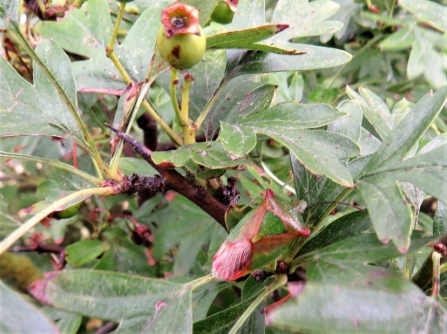
Hawthorn shieldbug c. Steve Holmes
I started within Thornton-le-Moors wood, checking on the Parent Bug horde and despite the light drizzle, it took just seconds to find around 50. A nice Sparrowhawk circled overhead for a short while too. After leaving the others to cover the northern part of the reserve I spent a little time in the wood looking for leaf mines and turned up a few species without anything to write home about. However, along the road south there was to be a few mines of Stigmella perpygmaella and the first of several Red Admirals. The eastern end of Speckled Wood Lane, devoid of birds or bird sounds even was only lacking tumbleweeds so yet again insects took centre stage. Increasingly more moth leaf mines are ‘available’ for detection these days and several more species (including Phyllonorycter coryli and Phyllonorycter corylifoliella) were simple enough to find, as were Neuroterus numismalis galls on Oak. At the s-bend in the lane a BUFF FOOTMAN showed nicely, just the second reserve record and then Willow Warblers were heard calling. In the end there were to be three, but since the species has been totally absent on the reserve this breeding season the question as to them being migrants (they were all adults) begged being asked. It’s certainly not too early for return passage to have begun and a Green Sandpiper was heard adjacent to the lingering remnants of the pond in SJ4373. Before the pond however there were other highlights: the first PARASWAMMERDAMIA NEBULELLA micro-moth for the reserve a 22-spot Ladybird, several Speckled Woods and Argyresthia bonnetella plus the first Hawthorn Shieldbug of the year. The latter is getting increasingly difficult to find these days.
Two female Kestrels were around the pond and one was inadvertently disturbed from the perch of the nestbox (though it returned within a few minutes). Butterflies became more frequent, especially and as might be expected, Gatekeeper and Meadow Brown, though there were two more Red Admirals. In quick succession there were then new records for the reserve of the hoverfly PLATYCHEIRUS MANICATUS the macro moth SLENDER PUG, as well as the second ever EPINOTIA NISELLA. However, in terms of sheer difficulty in finding, the larva and cocoon of BUCCULATRIX BECHSTEINELLA on Hawthorn was sighting of the day; I had only found the cocoon one time before –the mines being easier.
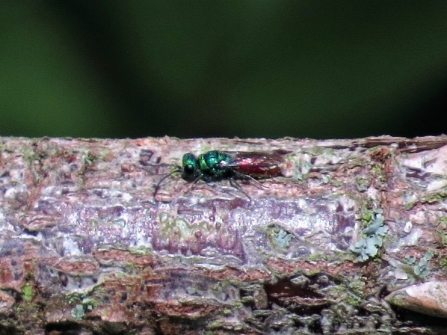
Ruby-tailed wasp c. Steve Holmes
Before heading back north and then home, I spent a few minutes looking for dragonflies on one of the ditches, recording five species without much ado and including an Emperor well away from their usual stronghold of the river.
Dozens more Meadow Browns lifted out of the long grass at just about every footfall, but nothing more of great moment was recorded until I was back on the lane leading down from the church in Thornton-le-Moors, when three more Commas were basking in the sunshine. Subsequently, whilst counting Gatekeepers my attention was drawn to a beautiful RUBY-TAILED WASP (Chrysis ignita) another first for the reserve!
July 22nd
Initially dull and dreary but increasingly sunny and breezy.
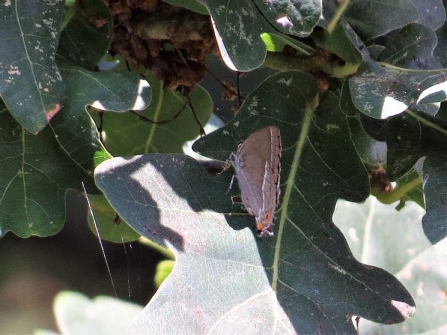
Purple hairstreak c. Steve Holmes
I almost chose to stay home today, such was the appearance of an incoming weather front from the south – horribly solid dull grey ominous looking clouds! Fortunately however the mind was changed on seeing that it was ‘breaking up’ and though still grey it was felt worth a go!
Marion dropped me off at the eastern end of Speckled Wood Lane and typically of late it was actually devoid of either birds or bird noises until the s-bend when things took a distinct upturn. However, whilst checking out the upper canopy of the largest tress along the lane for now assumed to be migrant warblers a PURPLE HAIRSTREAK showed nicely if briefly (photo, right). Better yet in reserve terms were leaf mines of the sawfly HETERARTHUS ACERIS, another first in what is turning out to be an extraordinary summer!
A Great Spotted Woodpecker called from up high but remained unseen and then Chiffchaffs came to centre stage; it was actually difficult to be sure just how many there were through them being so active but conservatively there had to have been 10, with no obvious juveniles. Nearer the western end of the lane I tapped a honeysuckle with my butterfly net and out popped a CRASSA UNITELLA micro moth, another first for the reserve!
Once out in the open Green-veined Whites, Meadow Browns and Gatekeepers started to show and there were four Kestrels in places to suggest that two pairs may be breeding this year – certainly the nestbox in SJ4373 looks to be one sure site and the other is presumed to be the same as last year – but I’ve not gone close for obvious reasons. Scanning to the north for raptors produced a single distant Buzzard then something over my shoulder drew my attention, two low, circling raptors. They were where Buzzards are commonplace, but these rang a mental bell for a closer look…the reserve’s first RED KITES! I have to say that I was so taken aback by this, I just watched them rather than took photos – until it was almost too late. Unfortunately, being early morning and looking east, the images are all practically silhouettes but the forked tail is clear to see. They split apart, drifted north independently but in the end were seen heading slowly east together, having been on show for about two minutes.
Understandably, the rest of the day was rather ‘after the Lord Mayor’s Show’ yet not without further highlights. In the increasingly warm and sunny weather there were butterflies aplenty though numbers of dragonflies in general and Banded Demoiselles in particular along the River Gowy was peculiar. For the first time in a while I chose to walk the length of Thornton Brook, which was actually very busy with dozens of the dominant Green-veined White, Gatekeeper and Meadow Brown. Five Stonechats included at least one fledged youngster, whilst Sedge Warbler was also a regular sight. An adult Frog however was a rare sight; there are days when thousands of tadpoles can be recorded but adults are decidedly uncommon and I couldn’t bring the last one time mind. Having seen the odd Cinnabar larva on Ragwort during the day, the continuous strip of the plant along the Brook was clearly worth a look and clearly so as they produced the third largest count ever (420) for the reserve – the two higher counts also coming from the same plants, peaking at 800 on 20th July 2013.
I crossed over the brook on the stepping stones as I wanted to check out the pond in SJ4374 – to see if it was still there really, but hoping there might be a Green Sandpiper. I also wanted to check for Common Blue butterflies along the permissive footpath along the A5117. Success came on both fronts, with one of each target species being present. Interestingly, away from the river dragonflies were actually more numerous; ten Common Darters, six Four-spotted Chasers three Brown Hawkers and an Emperor were all recorded.
The dominant moth was the micro Agriphila tristella, of which there were hundreds – disturbed with practically every step. Another Shaded Broad-bar was more interesting but the day’s last highlight centred on the single UDEA PRUNEALIS – yet another reserve first! Surprisingly, this was actually the last notable event of the day as the entire walk home wasn’t interrupted by anything other than two Commas.

